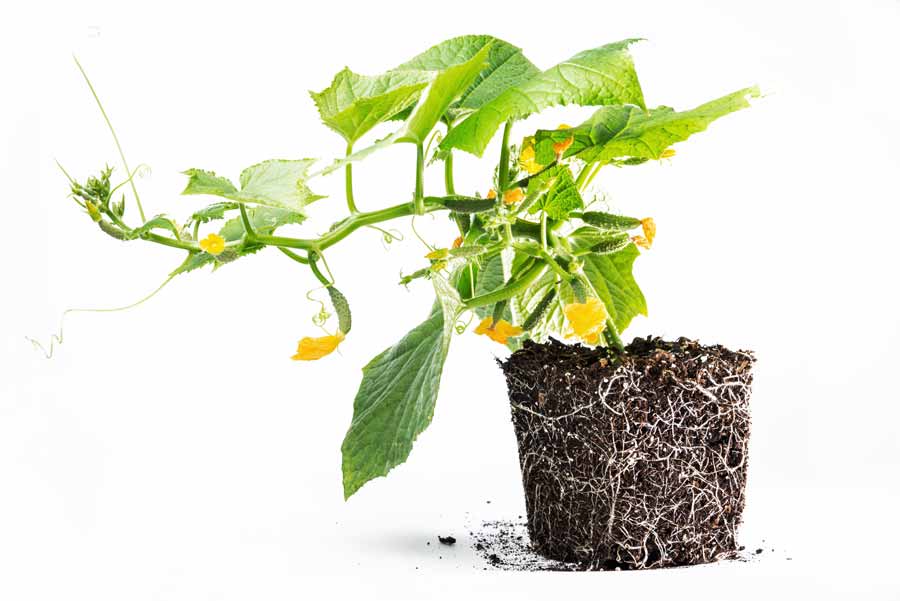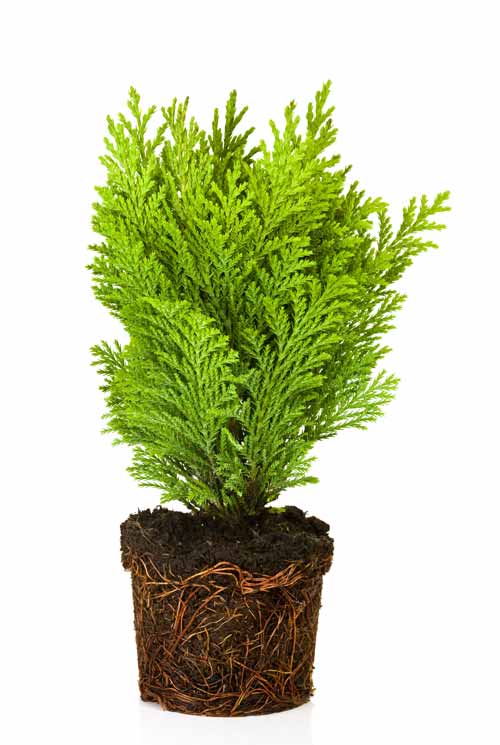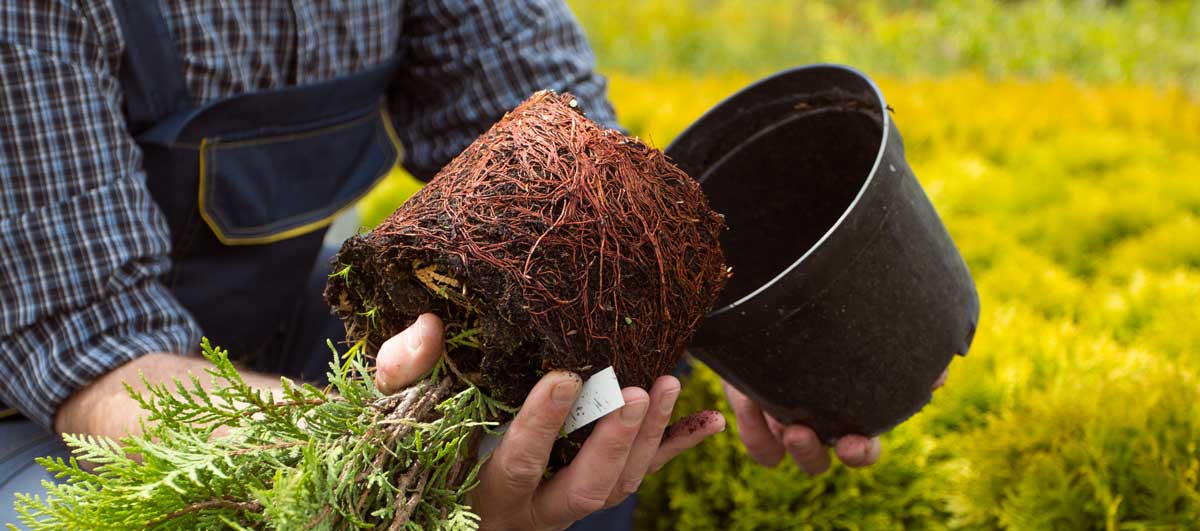Perhaps you have a neighbor growing tomatoes in a bag hanging from her porch rail. Maybe a friend shares with you a Pinterest board of gardens erupting from 5-gallon buckets that look like Swiss cheese. Or it could be that while looking for ways to grow more, you keep seeing these new containers covered in holes that claim to double your yield. No matter how you first discovered air pruning, it’s easy to see that modern growers everywhere are adopting this ‘air pruning’ style of container gardening. So now you are left with a crucial question: What is air pruning?
Air pruning is a natural phenomenon that influences root growth in plants. When expanding roots are exposed to air (particularly dry air), they stop growing. This is a perfectly logical adaptation – after all, why would a plant want roots growing above ground? Instead of continuing into the air, the root structure will change: many new fibers will grow laterally along its length to seek nutrients and water elsewhere.

Growers have learned to control air pruning for improved root growth. It began with arborists, who found that trees grown in containers for a few years lost their ability to be transplanted. Rather than growing a root system of broadly branching roots, the roots of these trees grew stunted and rootbound.
In an effort to correct this problem, tree-growers began experimenting with different container materials. When they tried using burlap bags, they discovered that the trees’ root systems grew robustly. The fabric allowed in enough dry air to signal to the root tips to stop growing and begin lateral branching. When transplanted, these trees took readily to the soil in their new homes.
But Plants Need Air, so Why does Air Kill Roots?
A plant’s carbon dioxide needs are absorbed from the air aboveground through small structures, called stomata, covering its stem and leaves. However, plants also need oxygen, which roots seek underground. The roots use oxygen to absorb and make use of nutrients in the soil.
The air that the roots absorb the oxygen from exists in tiny spaces between the soil particles. These pockets also hold moisture, which makes the air humid. Roots enjoy this humidity. It is the dryness of the air above ground that is the catalyst for air pruning.
So yes, plants need air – but only at the right humidity. Moisture in the air affects root growth as much as the air itself.
Understanding Root Growth
Roots play two vital roles in a plant: absorbing water and nutrients, and anchoring and supporting the aboveground growth. Like a house with a cracked foundation or a pop band with only one hit, a plant with weak roots will soon fall. So, before we can take full advantage of air pruning, we need to understand how roots work.
Root Anatomy
The anatomy of a root is fascinating. Plants begin with a single, seminal root. As the plant grows, all secondary roots feed into this main root. In some plants, this becomes the taproot, while other plants instead grow several ‘secondary’ roots that spread out and branch evenly into a fibrous network. A healthy root network is white, with a fresh, earthy scent. Brown, blackening, or sour-smelling roots are signs of disease.
Roots absorb nutrients and water all along their length. However, mineral absorption is by far greatest at the tip. The tip is specially designed with a protective ‘cap’ that helps it remain undamaged as it pushes past coarse particles in the soil. The space just behind this cap is where the greatest mineral absorption occurs. Behind the root tip, many small hair-like structures sprout. These hairs specialize in water absorption.
In a natural environment, root tips are free to grow in all directions. They can branch freely through the soil towards sources of nutrients and water. And as long as those root tips remain unfettered, they can continue to expand and support the plant. Those that reach the surface are air-pruned, allowing the plant to expend energy growing roots elsewhere.
Rootbound: The Scourge of Container Growers
Clearly, root tips being able to find water and nutrients is essential for a plant’s success. In a natural environment, roots are free to spread out indefinitely, thereby ensuring that the tips of its roots can find what they need. However, when a plant grows in a traditional container, its available space is limited.
The root tips of a plant growing in a traditional, non-porous pot will eventually bump into the sides and bottom. With no nutrients to be found, the root will use the ‘cap’ of its root tip to continue pressing against the wall of plastic or terra cotta, searching for a way around the obstacle. Around and around it will grow, unable to reach beyond the pot’s limitation, yet never getting the signal to give up and grow elsewhere. The result is rootbound plants.

The term rootbound refers to a plant that has a tangled, stunted root system due to a lack of space for the root ball to grow. In the words of Julia Walker, “The roots may spiral, twist, kink or become strangled.” Rather than branch into new parts of the soil, these roots continue to weave against the pot in vain.
A root-bound plant is at risk of nutrient deficiencies. There may be a fair amount of soil in the pot, but the root tips can’t find it. They will continue to grow against the inside of the container long after all the nutrients at the soil’s edge have been absorbed. Meanwhile, they will never sprout new roots laterally to grow into the soil still at the center of the pot.
When you remove a root-bound plant from its container, it will immediately become obvious if the plant is root-bound. Everything – plant and soil – will come out of the container as a single, compacted mass. Most of what you will see is root, with little soil visible. The roots will have grown in long loops and squiggles against the inside of the pot, appearing like cobwebs, spaghetti, or rope. There will be few branches, and little or no fibrous growth near the tip. If you have a plant like this, its roots must be properly pruned, and it must be repotted in a larger container.
Pruning root-bound plants can be difficult. If the roots are still white and healthy, you may be able to untangle them by hand. Tougher cases will require you to snip away tips that are tangled together. In the case of a heavily rootbound plant, you can try making deep vertical cuts to loosen the roots and allow air to reach the inner part of the root ball. Finish by trimming the longest roots so that the remaining ones are roughly equal in size.
Air Pruning is for You
Once you have dealt with the disappointment of root-bound plants in traditional containers, you may decide it’s time to branch out into the world of air pruning containers. Upgrading to air pruning containers is an investment, so it pays to do your research.
Since arborists’ successful use of burlap bags, growing containers have undergone several innovations. Manufacturers began making seedling containers with vertical slots on each side to ‘kill’ root tips and encourage denser root growth. Designers experimented with fabrics and air-hole patterns, searching for ways to maximize air pruning’s benefits. Decades of pursuing the balance between air-permeability and structural integrity have resulted in growing containers that would make the Green Giant jealous. Be they fabric or plastic, hanging or earth-bound, there are dozens of wonderful grow bags to choose from.
Air Root Growing Containers
Now that you understand how beneficial air pruning is for your plants, I am sure you are itching to find the best containers. You should begin your search by determining which design is best for you: grow bags or containers.
Air Pruning Grow Bags
Grow bags (also known as grow pots or fabric pots) are made from a variety of fabrics. These fabrics have a few traits in common: They are breathable, they are sturdy enough to handle the elements, and they can drain away excess water. If you are working with fine soils, grow bags are the way to go. Their fabric weave lets air permeate without losing your dirt.
Some grow bags have support rings or ribs sewn in, which give them a semi-rigid shape. Other bags look like a sack until they are filled. Semi-rigid bags are easier to fill and have a reassuring sturdiness about them; those without support are easier to fit into odd spaces or blend with the natural curves of landscaping.
When it comes to temperature-sensitive plants, grow bags have the upper hand. Because of their permeability, grow bags lose water to evaporation quickly. Consider using mulch to help retain moisture.
Air Root Pruning Containers
Air pruning containers are generally made of plastic and covered in a network of holes. These holes are typically ¼” to 3″ diameter circles; or vertical slots 1/8″ to ½” wide. Studies at the University of Florida determined that a minimum ratio of 10:1 material to space is needed to create conditions for sufficient air pruning.
The container may be crinkly-thin, like nursery seedling containers, or thick and sturdy like a bucket or PVC pipe. Some look merely functional, but some are aesthetic joys. Beyond their looks, however, you should match the container style with the soil you will use. Soils heavy in loam, peat, and clay tend to clump together, so they can do well in containers with larger holes. Sandy or chalky soil needs smaller holes or they will spill out over time.
Whether you decide that bags or containers are the best way to incorporate air pruning into your gardening, you can look forward to several benefits. Air pruning creates a branching root structure, which means your plants can absorb nutrients more quickly and use all available soil. The uniform holes in the container create even evaporation from the soil, thereby discouraging root rot.
Where do I Find the Best Fabric Pots?
Have a look at our hydroponic store finder to find a location near you!
How do I Know if I’m Doing it Right?
Once you have your plants established in your new air pruning containers, you probably wish you had x-ray vision so you could watch how well your root balls are developing. After all, how else can you know if this air pruning thing is really working? If you don’t have the patience to wait until harvest, keep an eye on the container holes. If you see moist, white root tips poking through the side of your containers, you need to make some adjustments.
Air pruning works when dry air reaches the root tip. So either your plants are not getting enough air through the soil, or the air is too humid. To solve this problem, try putting your pots up on benches, adding a fan, or moving them near a window.
meta description
What is air pruning? Understanding air pruning may be the breakthrough you are looking for to increase your crop yield and maximize nutrient absorption. Plant roots have evolved to grow deep into the ground in search of nutrients. If a root grows upwards it comes in contact with air, which causes the root tip to cease growing. The dry air causes the root to self-prune. Instead, the root sends out lateral, fibrous roots to search for new nutrients. This natural adaptation ensures that plants grow healthy root systems. Gardeners have begun to apply this adaptation to their own gardens. Air pots, grow bags, fabric pots, air pruning containers — whatever their name, all work on the same principle. When growing roots come in contact with dry air, they stop growing. Instead, they sprout fibrous root fibers laterally to search for new nutrient sources.
Meta title
What is air pruning? Understanding air pruning may be the breakthrough you are looking for to increase your crop yield and maximize nutrient absorption. Avoid root-bound plants, create healthy root systems

Very informative description.. thank you Theodore.. I will try air pruning pots for my next batch of Dutch tomatoes..🙂
Is it a good idea to start from seed in air containers or not? Thanks
Yes, you can but usually you want to start seeds in a seedling tray.
wow . what great idea